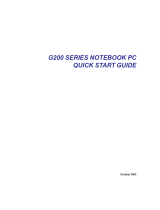
Copyright
Copyright and Trademark Information
Fujitsu Computer Systems Corporation has made every
effort to ensure the accuracy and completeness of this
document; however, as ongoing development efforts are
continually improving the capabilities of our products,
we cannot guarantee the accuracy of the contents of this
document. We disclaim liability for errors, omissions, or
future changes.
Fujitsu, the Fujitsu logo, and LifeBook are registered
trademarks of Fujitsu Limited.
Intel, Intel Core, Centrino, and Intel Centrino Pro are
trademarks or registered trademarks of Intel Corporation
or its subsidiaries in the United States and other countries.
Microsoft, Windows, and Windows Vista are either
registered trademarks or trademarks of Microsoft
Corporation in the United States and/or other countries.
The ExpressCard word mark and logo are owned by the
Personal Computer Memory Card International Associ-
ation (PCMCIA) and any use of such marks by Fujitsu
Computer Systems Corporation is under license.
PCMCIA is a trademark of the Personal Computer
Memory Card International Association.
Bluetooth is a trademark of Bluetooth SIG, Inc., USA.
OmniPass is a trademark of Softex, Inc.
Atheros and Super AG are registered trademarks of
Atheros Communications, Inc.
Roxio is a trademark of Roxio, a division of Sonic Solu-
tions.
Adobe, Acrobat, and Acrobat Reader are either a regis-
tered trademarks or trademarks of Adobe Systems Inc.
in the United States and/or other countries.
Norton and Norton Internet Security are trademarks or
registered trademarks of Symantec Corporation in the
United States and other countries.
PowerProducer is a trademark of CyberLink Corp.
The DVD player found in some models of the LifeBook
notebook incorporates copyright protection technology
that is protected by method claims of certain U.S.
patents and other intellectual property rights owned by
Macrovision Corporation and other rights users. Use of
this copyright protection technology must be authorized
by Macrovision Corporation, and is intended for home
and other limited viewing uses only unless authorized by
Macrovision Corporation. Reverse engineering or disas-
sembly is prohibited.
All other trademarks mentioned herein are the property
of their respective owners.
© Copyright 2007 Fujitsu Computer Systems
Corporation. All rights reserved.
No part of this publication may be copied, reproduced,
or translated, without prior written consent of Fujitsu.
No part of this publication may be stored or transmitted
in any electronic form without the written consent of
Fujitsu. B5FJ-3971-01EN-00
Warning
Handling the cord on this product will expose you
to lead, a chemical known to the State of
California to cause birth defects or other
reproductive harm.
Wash hands after handling.
DECLARATION OF CONFORMITY
according to FCC Part 15
Responsible Party Name: Fujitsu Computer Systems Corporation
Address: 1250 E. Arques Avenue, M/S 122
Sunnyvale, CA 94085
Telephone: (408) 746-6000
Declares that product: Base Model Configuration:
LifeBook E8310 notebook
Complies with Part 15 of the FCC Rules.
This device complies with Part 15 of the FCC rules. Operations are subject to the following two conditions:
(1) This device may not cause harmful interference, (2) This device must accept any interference received,
including interference that may cause undesired operation.
Eagle E8310.book Page 3 Thursday, May 3, 2007 2:55 PM




















